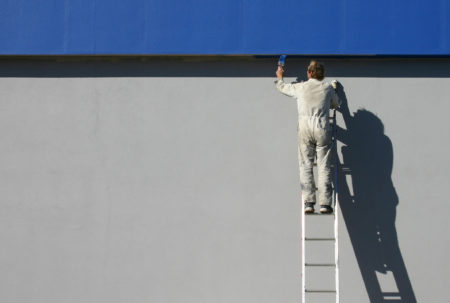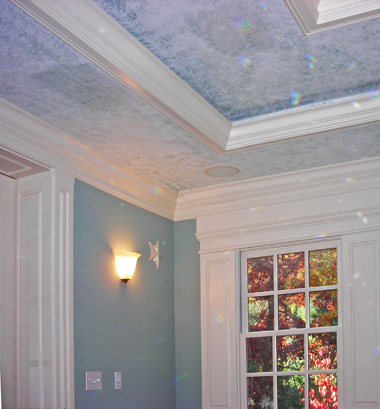There is virtually always a distinct difference between the quality of a professional paint job and a do-it-yourself project. Painting interiors and exteriors is also a lot less frustrating an experience for knowledgeable professionals. How do the pros do it? Well, they know all the little secrets handed down through time, from industry professional to industry professional – secrets that are not casually indulged for the benefit of the everyday layman. Although our professional painters love their craft and look forward to working with our clients, they are sharing a few secrets to help homeowners accomplish professional results on their own.
1 – Fully Prepare the Paint Surface
There are some things that should be done before opening the paint can. In fact, the paint prep work has everything to do with the quality of the finished product. The following are a few prep steps:
- If the walls you are painting are greasy, such as in a kitchen, or grimy, as in a mudroom, give them a good cleaning with a degreaser; otherwise, the paint won’t adhere to the surface. Degreasers are potent; wear rubber gloves and eye protection and follow directions carefully.
- Fix the surfaces so that cracks, dents, and bumps are spackled, puttied, or smoothed as needed. Otherwise, the bad spots will grab more attention than your beautiful new coat of paint.
- If you are painting a previously painted wall, sand the surface to be sure the walls are fully de-glossed.
- Sand away flaws and rough spots with fine-grit sanding paper before painting.
2 – Take it One Wall at a Time
It may seem more practical to first tackle trim and corners and then do walls, but that’s not how most pros do it. Professionals typically achieve a seamless look by completing one wall at a time, immediately rolling it before moving on to the next wall. This way, the rolled paint and the brushed paint blend together better.
To keep your paint and tools from drying out when you aren’t using them, cover paint cans, containers, or trays with a damp rag when switching from brushing to rolling and vice versa.
3 – Work with a Telescoping Painter’s Rod
Sometimes professional tools make all the difference. To make quick work of painting ceilings without having to climb up and down ladders, use a telescoping painter’s pole or rod that is 8 feet in length. With this great tool, you avoid being splattered with paint because you’re not standing directly underneath the area you’re painting.
4 – Use Quality Tinted Primer
As prep for painting walls, professionals patch cracks and fill holes with joint compound. It’s a mistake to paint directly over it because the compound draws the moisture out of the paint, and you end up with paint that looks dull and flat but only in certain spots. Priming the entire wall is a must; don’t spot prime.
Use alkyd and alcohol primers for best results; and rather than using white, choose a tinted shade that’s similar to the color of your finish paint. With tinted primer, you will achieve a more vibrant finish coat. Using a tinted primer, fewer coats may be required, such as if you are painting with orange or red shades, which could require three or more coats if a primer is not used first.
5 – Use a Loaded Brush
One of the most common faulty methods of painting for do-it-yourselfers is to dip the paint brush and wipe it along the side of the paint can before applying the paint to the surface. Professionals load the brush at a depth of about 1 ½ inches, tap each side against the inside of the paint can to eliminate heavy drips, and then immediately apply the paint to the surface.
We have a lot more professional paint secrets but here you have five of them and we hope it helps. Be sure to check out all of our services, many of which should probably only be tackled by a professional.
Franklin Painting LLC – Call us Toll Free at 877-646-7774
or at our main office number 860-678-7701
2 Eastview Drive, Farmington, CT 06032
Exterior House Painting in CT towns like farmington, ct 06032 – avon, ct 06001 – simsbury, ct 06070 – west simsbury, ct 06092 – canton, ct 06019 – burlington, ct 06013 – bloomfield, ct 06002 – unionville, ct 06085 – weatogue, ct 06089 – suffield, ct 06078 – windsor, ct 06095 – granby, ct 06035 – collinsville, ct 06022 – west hartford, ct 06110 – 06117 – 06119 – 06127 – 06133 – 06137 / bristol, ct 06010 – new britain, ct – 06050 – 06051 – 06052 – 06053 / newington, ct 06111 – wethersfield, ct 06109 – cromwell, ct 06416 – rocky hill, ct 06067- berlin, ct 06037 – kensington, ct 06037 – portland, ct 06480 – middletown, ct 06547 – meriden, ct 06450 – middlefield, ct 06455 – east hampton, ct 06424 – chesire, ct 06410 – southington, ct 06489 – glastonbury, ct 06033 – south glastonbury, ct 06073- south windsor, ct 06074 – elllington, ct – east windsor, ct 06088 – hebron, ct 06248 – marlborough, ct 06447 – manchester, ct 06040 – 06042 – 06045 – bolton, ct 06043 – colchester, ct 06415 – tolland, ct 06084 and more!

Frank Campanelli, the esteemed founder of Franklin Painting LLC, has been leading the company since 1986. He takes immense pride in the stellar reputation his dedicated team has built by consistently delivering top-notch service to each customer.




